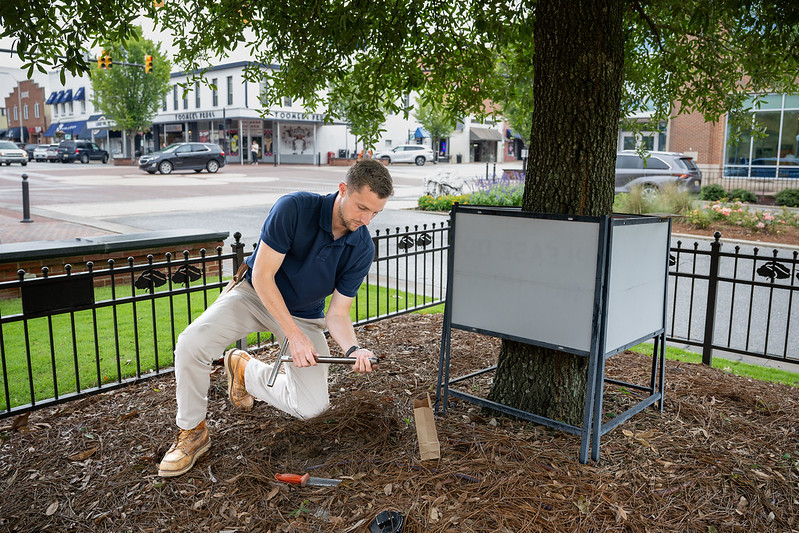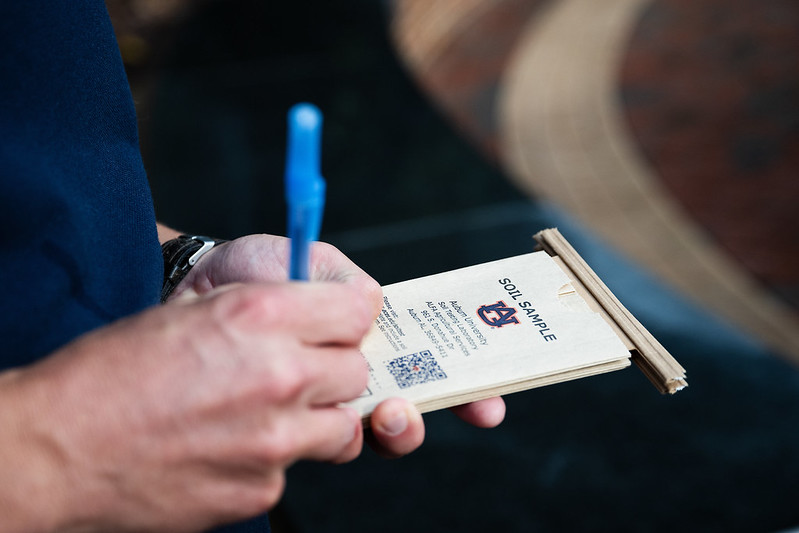Auburn University arborist dedicates career to health of campus trees, including famed oaks
Article body
If you find Alex Hedgepath at Toomer’s Corner, chances are he’s not there for the rolling of the oaks but for something just as important – the health of the trees.
While he respects that Auburn fans embrace the longstanding Auburn tradition of throwing toilet paper into the trees after a big Auburn win, Hedgepath — Auburn’s university arborist — has a surprising admission:
“I’ve never rolled Toomer’s Corner,” he says in an almost apologetic tone, standing in the shade of the famed oaks and smiling sheepishly.
What Hedgepath and several others on Auburn’s landscape crew have done and will continue to do at the corner, though, is worthy of its own celebration, perhaps just as much as an Auburn victory. It is their hard work that is preserving the oaks for generations to come and, most recently — along with the contribution of Auburn fans not rolling the oaks — helping make possible a return to rolling the two newest oaks at the corner this football season.
“These two trees definitely deserve their own unique management plan, catered to them — obviously, considering what they’re going to have to withstand in the future, knowing they’re not just any other tree on Auburn’s campus,” said Hedgepath, who graduated from Auburn in 2012 with a Bachelor of Science in forestry and started working for the university eight years ago. “They will be the Auburn Oaks at Toomer’s Corner, and they’re going to get rolled after every significant athletic win.”
Stepping into a labor of love
For a guy whose last name is Hedgepath, some might say he was destined to step into a career involving the great outdoors.
“I always knew I wanted to go the urban route,” he said. “I had a landscape background, so I was just trying to kind of marry those two fields and landed in urban forest management.”
Little did he know at the time that his path would one day lead him to Toomer’s Corner — a place he rarely frequented as a student. When he arrived to Auburn in 2009, he was married, working and heavily committed to forestry school studies. Thus, why he didn’t roll the corner at that time.
“I didn’t have your typical college experience. I was married, so I had to work a lot,” he said. I was working close to 30 hours and going to school full time as well. I just didn’t have time to prioritize football, much less come up here to roll.”
Hedgepath started working at Auburn in 2015 under the leadership of Beaver Johnston, who braved Auburn’s Landscape Services through the poisoning of the original Toomer’s Oaks.
“I was delighted to have the opportunity to apply for a role that could have real impact and be able to join a team with so much historical significance on campus over the years,” Hedgepath said. “I’m blessed to have leadership now that continues to value tree health.”
Justin Sutton, director of Landscape Services, is a certified arborist and has made provisions to bolster the Facilities’ Tree Care Team. The in-house team of arbor specialists is led by yet another certified arborist, Dalton Sconyers, the in-field tree care supervisor.
“You can see I have a lot of help, and we truly work together to care for Auburn’s tree canopy,” said Hedgepath.
A lofty dedication
Dan Whatley, assistant vice president of Facilities Operation at Auburn, says that team deserves a lot of credit.
“I am incredibly proud of the excellent work performed day-in and day-out by our tree care team that Alex leads,” he said. “They are truly dedicated to their craft and work to preserve the integrity our of tree canopy through regular safety inspections, revitalizing care and necessary pruning activities. Their diligence in caring for the Auburn Oaks is what has gotten us to the point where we can return to the tradition of rolling Toomer’s Corner.”
Today, Hedgepath and that team of arborists oversee the care not only of the famed oaks, but of the other approximately 10,000 trees that shade Auburn’s campus. Hedgepath stays busy keeping campus trees healthy while also making sure pedestrians are safe as they take a stroll beneath Auburn’s variety of trees.
“My day-to-day at Auburn consists of a number of things, but mainly I approach my work in terms of urban forest management,” he said. “This consists of tree risk assessment, integrated pest management and the planning of successional trees to be planted. There’s now a heavy emphasis of making sure that our streets and our concourses are safe, that the canopy that overhangs those spaces can be enjoyed without a high threat of tree failure.”
Concerning the oaks at Toomer’s Corner, Hedgepath recalls when they arrived in 2017. He analyzed the root balls while the trees were still on the delivery truck, noticing that all looked good.
“So, yeah, they were ready to go with new fibrous roots pushing from the root ball,” he said. “And once they were installed, we were relieved because they were obviously huge trees.”
Since then, there have been various methods of monitoring and maintenance of the trees to ensure their health. For one thing, Hedgepath said a third-party expert consultant was brought in to “help us dial in how to promote vigor without pushing too much growth allowing the trees to establish as soon as they can so that we can get back to the tradition.
“And we do want them to be healthy and vigorous and to occupy and dominate this corner like the old ones used to.”
Maintenance of the trees involves weekly checks, as well as monitoring of everything from soil samples to shoot elongation.
“They’ve actually reached a point of canopy expansion that we can start pruning them actively and structurally pruning them,” he said. “And then there’s a balanced fertilization program. I don’t want anybody to think that we’re just pounding these trees with fertilizer just to push them to expand their canopy.
The right path forward
“There’s a right way to do it and a wrong way to do it,” Hedgepath said. “All of our fertilization is coming from a soil analysis that’s current. So, we take a soil sample, send it to the lab, it comes back and tells us what the deficiencies in nutrition are. We supplement it to bring them up to a standard level.”
There’s even an automated irrigation system that includes four moisture sensors for each oak. The sensors are connected to a digital irrigation software that can be accessed in Hedgepath’s office.
“So, basically, it allows us to know how much water the trees are receiving at any given time,” he said. “It’s not like there’s a cyclical irrigation schedule where every Monday, Wednesday, Friday, they’re getting water. They get water when they need it.”
Another check involves root elongation to gauge how much the root system is growing below ground, which Hedgepath says is the true measurement of establishment for transplant success. The trees likewise are checked for pests and diseases, but Hedgepath said southern live oaks are tough trees and are often resistant to decay.
And then there’s the consideration of tossed toilet paper to take into account. Hedgepath said the cleanup crew does an amazing job following an Auburn win, some having worked in that role for more than 20 years.
“We really have a great deal of respect for the people that clean it up,” he said. “It’s not an easy job. It’s a ‘Mike Rowe’ dirty job.”
Preserving the path to tradition
Hedgepath said that when rolling occurs 30 to 40 feet high in the trees away from the corner, water has been used to spray down the toilet paper. Such a process, he said, can pose detrimental risk to those trees due to saturated soil and compaction.
“We really encourage people to roll the trees that are closest to the corner. Obviously, the Auburn Oaks at Toomer’s Corner are the primary targets. And those are also the easiest to clean up. We use manlifts and actually handpick it down. That seems to be the least impactful operation,” said Hedgepath, looking up and examining the oaks again.
Hedgepath said he’s honored to do his part to help continue the tradition of rolling Toomer’s Corner. But the big question is whether he’ll roll the corner for the first time this season?
“That’s tempting,” he said, pausing. “But I probably will not contribute to the rolling. It’s just because I know what’s involved in the cleanup.”
And, thankfully for Auburn fans, Hedgepath also knows what it takes to keep a tradition alive and well.
Related Media
Media interested in this story can contact Communications Director Preston Sparks at (334) 844-9999 or preston.sparks@auburn.edu.
Auburn University is a nationally ranked land grant institution recognized for its commitment to world-class scholarship, interdisciplinary research with an elite, top-tier Carnegie R1 classification, life-changing outreach with Carnegie’s Community Engagement designation and an undergraduate education experience second to none. Auburn is home to more than 30,000 students, and its faculty and research partners collaborate to develop and deliver meaningful scholarship, science and technology-based advancements that meet pressing regional, national and global needs. Auburn’s commitment to active student engagement, professional success and public/private partnership drives a growing reputation for outreach and extension that delivers broad economic, health and societal impact.






